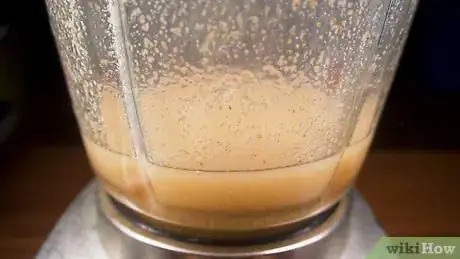This article was co-authored by Yoko Isassi. Yoko Isassi is a Japanese Food Specialist and the Founder of Foodstory in Los Angeles, California. Since 2011, she has taught others how to cook Japanese food and educated others about Japanese food culture. Yoko holds an MA from Columbia University.
This article has been viewed 111,971 times.
Sesame oil is a flavorful cooking oil that is rich in calcium, copper, zinc, iron, and magnesium. It is also very beneficial for overall skin health because of these minerals. To make sesame oil at home, toast the seeds until they are golden brown, mix them with a cooking oil of your choice, and blend up the seeds. At this point, the sesame oil forms on the top of the ingredients. Refrigerate your sesame oil for up to 2 years so you can easily use it to cook many delicious meals.
Steps
Toasting the Seeds
-
1Use about 3 cups (710 g) of seeds to make 1 cup (237 mL) of oil. Use more or less sesame seeds based on how much you have available and how much oil you want to yield.[1]
- Making 1 cup (237 mL) of sesame oil is a good amount for general cooking and skincare needs. If you want to make a lot in advance, double or triple the amount of sesame seeds.
-
2Bake the sesame seeds at 350 °F (177 °C) for an effortless option. To do this, spread the seeds across a baking sheet. Then, place the baking sheet in the middle of your oven rack. After 5 minutes, stir up the sesame seeds so they don't burn. Then, cook them for another 10-15 minutes. Your sesame seeds are thoroughly toasted when the outside is a golden brown color.[2]Advertisement
-
3Toast the seeds in your stovetop to ensure they don’t overcook. Place your sesame seeds in a saucepan and set your stovetop temperature to medium. Heat up the seeds for 10-15 minutes, and continuously stir the sesame seeds with a mixing spoon as they warm up.[3]
- You should notice a pleasant, nutty aroma as the seeds toast.
- Sesame seeds will start popping out from the pan as its heated up. Use a mesh screen (like the one you use to block splattering oil) to cover the pan if you'd like.
-
4Remove your sesame seeds from the heat when they are golden brown. Whether you are using the stovetop or the oven, put your sesame seeds on a plate after they turn a golden brown shade. This way, the seeds cool down quicker.[4]
- The golden brown color is a sign that the sesame seeds are toasted properly.
- You can also stop cooking when you start smelling the roasted sesame seeds.
-
5Avoid overcooking your sesame seeds. If your seeds turn medium-dark brown, they are overcooked and will not produce great sesame oil. To prevent this, watch your sesame seeds closely throughout the toasting process. Remove them from heat as soon as they become a light shade of golden brown.[5]
- If you overcook your sesame seeds, that’s okay! Simply throw them out and try again.
Blending the Sesame Seeds
-
1Mix every 1/4 cup (59 g) of sesame seeds with 1 cup (237 mL) of oil. Pour your sesame seeds inside a medium or large pot. Then, pour in a cooking oil of your choice, based on the amount of sesame seeds you are using. You can use either peanut oil, sunflower seed oil, vegetable oil, or coconut oil to help you separate the oil from the sesame seeds.
- If you are using 3 cups (710 g) of sesame seeds, use 12 cups (3 L) of oil.
- All of these work well to help you extract the sesame oil.
-
2Heat the oil and sesame seeds on your stovetop for 5 minutes or so. After you mix together the sesame seeds and cooking oil, use a medium heat setting to warm up the ingredients. Warming the sesame seeds in the oil helps extract more of the oil from the seeds.[6]
-
3Pour the mixture into a blender. Once the oil is warmed up, turn off the heat and place your blender in the sink. Carefully pour the oil and seeds from the pot into the blender, aiming to get as much as you can inside.
- This way, you can separate the cooking oil from the sesame oil.
-
4Blend up the sesame seeds until they are broken into small pieces. Put the lid on your blender and select a medium chop setting. Blend the ingredients for 1-4 minutes or until the seeds are broken down. You can stop blending when the seeds look completely crushed up, rather than in granules.
- The ingredients should easily mix together because of the cooking oil. If you have difficulty, try stirring the ingredients or using a higher heat setting.
-
5Let your ingredients sit for 45 minutes to 2 hours. After you blend up the ingredients, let it sit in the blender for a while. The sesame oil rises to the top, and you can easily separate it after the other oil sinks to the bottom. Depending on what oil you used, the sesame oil may separate at different rates.[7]
- For instance, when using peanut oil, it may only take 45 minutes for your oil to separate. If using sunflower seed oil, it may take up to 2 hours.
Separating the Oil
-
1Pour the mixture through cheesecloth if using an oil other than peanut. Pick a small- or medium-sized bowl and stretch the cheesecloth over top. Secure the cheesecloth with a string or rubber band. By doing this, you easily extract the sesame oil from the cooking oil.[8]
- Using cheesecloth ensures no seeds get inside your oil.
- Do this if you used sunflower oil, coconut oil, or vegetable oil
-
2Use a bowl to naturally let the oil separate if you're using peanut oil. If you used peanut oil, the separation process is slightly different. Simply pour your ingredients into a bowl, and let it sit for at least 45 minutes. At this point, the sesame oil naturally raises to the top.[9]
- With peanut oil, you do not need to pour the ingredients through cheesecloth since the oil easily separates on its own.
-
3Pour the sesame oil into an airtight container using a spoon. If you poured the oil through cheesecloth, simply pour the strained sesame oil into a glass jar or plastic container. If you are using peanut oil, use a large metal spoon to transport the oil little by little into your container or jar.[10]
- For example, use a liter-sized mason jar with an airtight lid.
-
4
Things You’ll Need
- Sesame seeds
- Saucepan or baking sheet
- Blender
- Cooking oil
- Spoon
- Bowl
- Cheesecloth
- Storage container
- Refrigerator
References
- ↑ http://convert-to.com/564/sesame-oil-conversion-and-nutritional-facts-info.html
- ↑ http://www.sesameoilforskin.com/how-to-make-sesame-seed-oil-at-home/
- ↑ https://youtu.be/iNvRY-AeEcs?t=1m10s
- ↑ http://www.sesameoilforskin.com/how-to-make-sesame-seed-oil-at-home/
- ↑ http://www.sesameoilforskin.com/how-to-make-sesame-seed-oil-at-home/
- ↑ http://www.sesameoilforskin.com/how-to-make-sesame-seed-oil-at-home/
- ↑ http://www.sesameoilforskin.com/how-to-make-sesame-seed-oil-at-home/
- ↑ http://www.sesameoilforskin.com/how-to-make-sesame-seed-oil-at-home/
- ↑ http://www.sesameoilforskin.com/how-to-make-sesame-seed-oil-at-home/
About This Article
To make your own sesame oil, start by toasting sesame seeds on a baking sheet at 350 degrees F. After about 5 minutes in the oven, stir them up and put them back in for another 10-15 minutes. When the seeds look golden brown, take them out and put them on a plate to cool. Then, pour the cooled seeds into a large pot, add oil, and heat the mixture on the stove for 5 minutes. Once the mixture heats up, transfer it to a blender and process it for 1-4 minutes, or until the seeds break into small pieces. Let the blended mixture sit for 45 minutes to 2 hours before pouring it through a cheesecloth to separate the oil. Finally, store the oil in a glass jar with an air-tight lid and keep it in the fridge! For more tips, like how to know if your sesame oil is spoiled, read on!























































